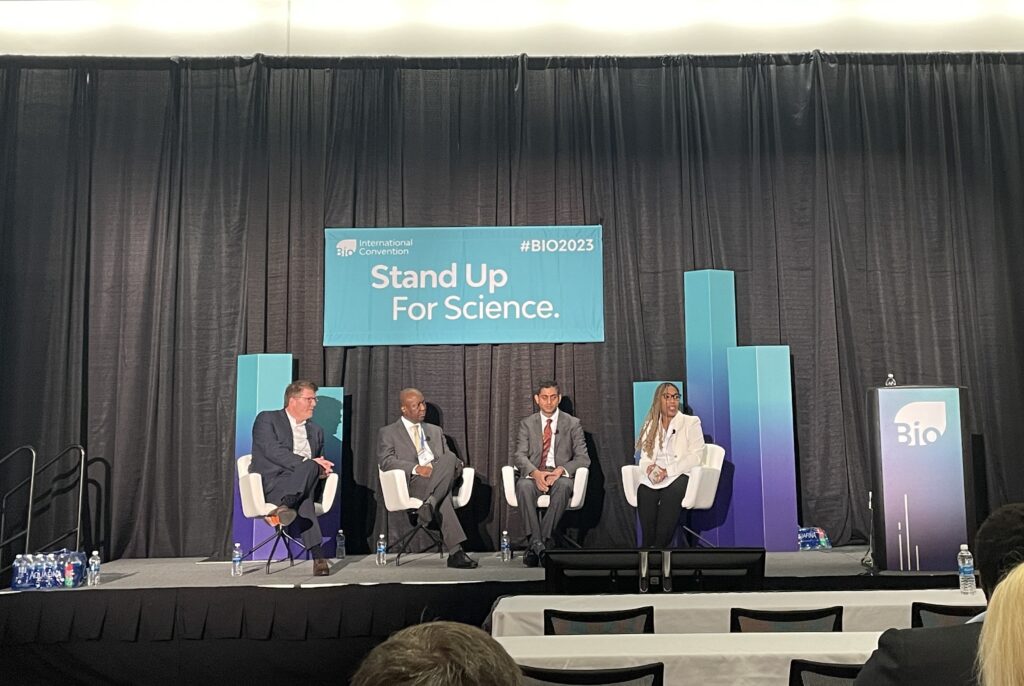According to the World Health Organization (WHO), “Cardiovascular disease (CVD) is a leading public health (and economic issue) in the United States,” a fact underscored by Kinetra Joseph, Campaign Director of Million Hearts Alliance with the CDC Foundation, and moderator for the session “Navigating Patient Access Barriers to Solve Public Health Challenges in Cardiovascular Disease” at the 2023 Biotechnology Innovation Organization (BIO) International Convention. Joseph emphasized, “The total cost of cardiovascular disease in the United States is expected to reach 1.1 trillion dollars by 2035.”
CVD has been a priority for the healthcare industry and public health advocates for years. Despite significant advancements in treatment and updated guidelines, it remains a burden for patients and healthcare systems, from diagnosis and disease management to delivery of guideline-directed treatment.
Jasper van Grunsven, Vice President, General Manager-General Medicine at Amgen, has been with Amgen for the past 10 years. Van Grunsven has seen the impact of cardiovascular disease across the globe and considers his interest within the field to be both professional and now personal, as his father suffers from heart disease.

Anekwe Onwuanyi, M.D., President of Association of Black Cardiologists, is involved in both training the next generation of cardiologists, as well as researching the disparity gap concerning both quality and economic issues within the field.
Speaking to the problem of access in healthcare, Dharmesh Patel, M.D., MBBS, President of Partnership to Advance Cardiovascular Health, reiterated the importance of bridging the gap of access between the patients and the care they need. Patel stated that “despite advances in medical therapies, incidence of cardiovascular disease has increased.” Reasons include rising risk factors that involve less activity, child obesity and diabetes, as well as poor nutrition. The solution involves not only establishing a diagnosis, such as elevated cholesterol, for example, but providing the patient with therapies as well as solutions to the barriers that exist for them receiving the care that they need.
Identifying high-risk patients
Amgen partnered with the Family Heart Foundation whose mission is to identify high-risk individuals with familial hypercholesterolemia (FH), a genetic disorder that increases the likelihood of having coronary heart disease at a younger age, via innovative technologies. They additionally aim to provide the education and screening necessary to patients and families at greatest risk.

Van Grunsven emphasized the “significant gap between the number of prescribed (3%) versus the number of guideline-recommended (>60%) lipid-lowering therapies in patients with CVD.” Patel agreed and added that the “disparity is likely even more than previously suspected with the addition of the Expert Consensus Decision Pathway.” In January 2023, the Journal of American College of Cardiology published the “Expert Decision Pathway for Integrating Atherosclerotic Cardiovascular Disease and Multi-Morbidity Treatment,” which recommended shifting to prioritized therapy with the greatest overall benefit while aligning with the patient’s preferences.
How disparities affect access

Joseph stated that, in her work at the CDC Foundation and Million Hearts Alliance, “they frequently acknowledge and cite the fact that cardiovascular disease is the number one contributor to all racial disparities in life expectancy.” Dr. Onwuanyi added that access to healthcare across the country is variable, and solutions require the provider be both innovative and intentional. This includes “understanding barriers with insurance, transportation, and patient education in order for patients to have access to quality care and technological advancement and device therapies.”
Speaking of the trust between patient and physician, Dr. Patel detailed his experience in rural Tennessee and acknowledged that, although some of it is cultural, it is a true barrier that needs to be addressed in order to successfully care for patients. The panel agreed guideline-directed lipid-lowering therapies are significantly more often prescribed to caucasians and those with high-income or college educations.
Dr. Patel continued, “Disparity exists, and female patients, those with Hispanic or African American descent, or those in southeastern United States, all are less likely to receive proper therapy” for hypercholesterolemia (high cholesterol), for example. As certain insurance companies are restricted to the therapies they approve, “Therapy is often based on the type of insurance patients possess rather than on what the patient actually needs.”
National and local collaboration
Collaborations and teamwork exist on both national and local levels, even though they approach issues in a different way. On a national level, van Grunsven explained, “Stakeholders and associations (i.e., American College of Cardiology [ACC], American Heart Association [AHA], National Lipid Association [NLA], and Family Heart [FH]) came together and collectively established a set of objectives in order to achieve the ambitious goal of lowering CV events by 15% by 2030.” This van Grunsven called a “partnership for impact.”
Another collaboration with Amgen resulted in a collective database which revealed LDL-C testing gaps. These initiatives are only a few of which that are intended to advance and improve guideline-directed therapies in order to decrease the number of CV events. Patel agreed that collaboration is the most effective way to bring about change. This occurs when the patient’s voice is included within legislative and local discussion.
CV care for all communities
In regards to the data obtained through teamwork, Dr. Onwuanyi emphasized the “importance of standardization of processes to guide treatment, though it is not enough to have guidelines in place without the ability to implement them.” In the midst of creating coalitions, however, patients continue to need care and require advocacy on their behalf.

Dr. Patel agreed and added there is another hoop to jump within patient care and that is pre-authorization. The average physician’s team, he explained, spends approximately 13 hours a week on pre-authorizations. Findings from a 2022 AMA physician survey are significant: 93% of physicians report treatment delays while waiting for insurers to authorize care and 82% report treatment abandonment for the same reason.
“CVD is primarily preventable today,” Dr. Patel continued, necessitating communication between specialties and their mutual patients. It is also the responsibility of leadership, per Dr. Onwuanyi, to ensure technological advances (TAVR, for example) within the CV space are equally accessible to all communities. In the meantime, discussions continue within the CV community, applying persistence and gaining traction on solutions for change and treatment equity.




